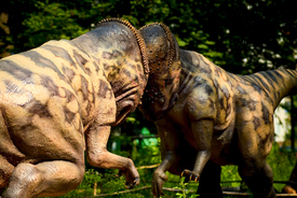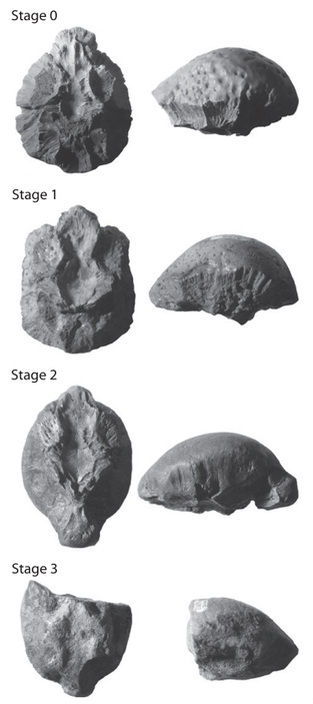by Caitlin Syme
As palaeontologists, we spend quite a bit of time trawling the internet to keep up-to-date with new fossil discoveries and hypotheses. The UQ Palaeo Blog is a great place for us to let you know about the interesting and exciting ideas we've uncovered, such as this new study on the preservation and taphonomy of pachycephalosaur skulls.
Enjoy!
Pachycephalosaurids are a well know group of ornithischian dinosaurs from North America. If the name doesn't ring a bell, maybe these pictures will - apparently, the poor things were almost constantly butting heads with rivals, or charging off head-first for no apparent reason:
I always feel a sympathetic headache come on when looking at these pictures. Images from top left clockwise: rareresource.com; Maichol Quinto and Florian Stitz - Paizo Publishing; Ryan Steiskal; Wikimedia Commons.
While most debate has focussed on the function and behaviour of these dome-crested dinos, palaeontologists have also puzzled over why the dome-shaped skull is the most commonly preserved part of the pachycephalosaur skeleton. Researchers noticed that the domes were rounded and heavily worn, and presumed they had been bumped, scratched and scraped as they were carried along by rivers. From that, they inferred that pachycephalosaurs probably lived up-river from where their 'tough' skulls were eventually washed to and buried, and that the rest of the skeleton was broken down or lost on the down-river journey.
This hypothesis suggests that the domes are allochthonous – 'foreign' to the host rock, transported far from where the pachycephalosaurs lived, instead of autochthonous – 'native' to the host rock, fossilised near to where the pachycephalosaurs lived.
Jordan C. Mallon and David C. Evans refute this long-held view (what they call the 'Transport Hypothesis'). Instead, they propose in their new paper, "Taphonomy and habitat preference of North American pachycephalosaurids (Dinosauria, Ornithischia)", that (1) pachycephalosaur domes actually aren't actually that rounded, (2) roundness doesn't correlate with the distance a dome skull travelled anyway, and (3) pachycephalosaur fossils aren't more common in the up-river, intermontane areas that they supposedly habited.
They suggest that the domes are actually autochthonous, or possibly parautochthonous – that pachycephalosaurs lived in alluvial and coastal lowlands, closer to where their remains were fossilised than previously thought.
This new hypothesis may not be popular – the 'Transport Hypothesis' has been around since the 1930's. And unlike the 'Transport Hypothesis', it doesn't quite explain why there are many more dome skulls preserved than the rest of the skeleton. But just because an idea may not be popular, does not mean it is incorrect. I look forward to seeing how the rest of the scientific community responds to the hypothesis proposed in this paper.
This hypothesis suggests that the domes are allochthonous – 'foreign' to the host rock, transported far from where the pachycephalosaurs lived, instead of autochthonous – 'native' to the host rock, fossilised near to where the pachycephalosaurs lived.
Jordan C. Mallon and David C. Evans refute this long-held view (what they call the 'Transport Hypothesis'). Instead, they propose in their new paper, "Taphonomy and habitat preference of North American pachycephalosaurids (Dinosauria, Ornithischia)", that (1) pachycephalosaur domes actually aren't actually that rounded, (2) roundness doesn't correlate with the distance a dome skull travelled anyway, and (3) pachycephalosaur fossils aren't more common in the up-river, intermontane areas that they supposedly habited.
They suggest that the domes are actually autochthonous, or possibly parautochthonous – that pachycephalosaurs lived in alluvial and coastal lowlands, closer to where their remains were fossilised than previously thought.
This new hypothesis may not be popular – the 'Transport Hypothesis' has been around since the 1930's. And unlike the 'Transport Hypothesis', it doesn't quite explain why there are many more dome skulls preserved than the rest of the skeleton. But just because an idea may not be popular, does not mean it is incorrect. I look forward to seeing how the rest of the scientific community responds to the hypothesis proposed in this paper.
Fossil pachycephalosaur domes, showing the 4 stages of dome wear as classified by Mallon et al., 2014. The ventral (underside) and left lateral (left side) of each dome is shown. The skulls belong to the following species: Stage 0 – Hanssuesia sternbergi (CMN9148), Stage 1 – Prenocephale brevis (CMN8819), Stage 2 and 3 – Sphaerotholus edmontonensis (CMN8830 and CMN8832 respectively). Image from Mallon et al (2014).
References
Mallon, J.C., Evans, D.C. 2014. Taphonomy and habitat preference of North American pachycephalosaurids (Dinosauria, Ornithischia). Lethaia, DOI: 10.1111/let.12082.
Mallon, J.C., Evans, D.C. 2014. Taphonomy and habitat preference of North American pachycephalosaurids (Dinosauria, Ornithischia). Lethaia, DOI: 10.1111/let.12082.





 RSS Feed
RSS Feed
